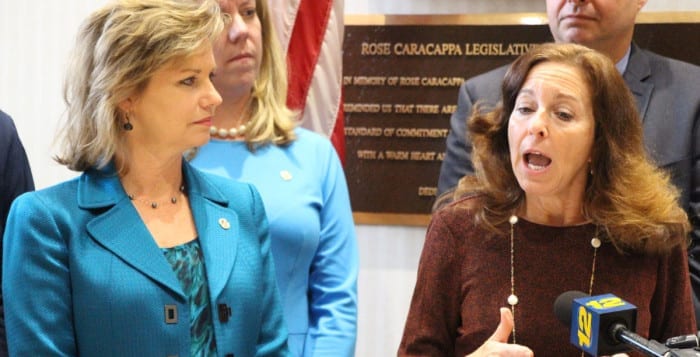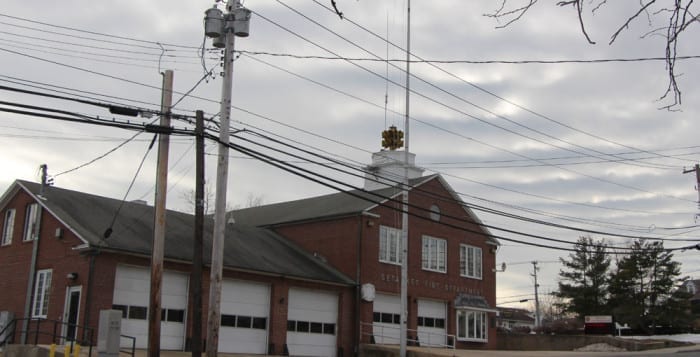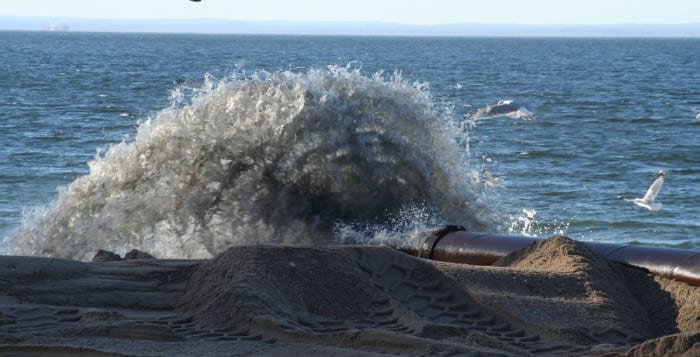It’s been about six months and North Shore leaders are still fighting against the U.S. Army Corps of Engineers’ proposal to continue dumping dredge spoils into the Long Island Sound.
Suffolk County Legislator Sarah Anker (D-Mount Sinai) stood alongside fellow county Legislators Al Krupski (D-Cutchogue) and Kara Hahn (D-Setauket) on Tuesday at the William H. Rogers Legislature Building in Hauppauge to voice their opposition to the plan and ask Gov. Andrew Cuomo (D) and New York Secretary of State Cesar Perales to reject the proposal. George Hoffman of the Setauket Harbor Task Force and Adrienne Esposito, executive director of Citizens Campaign for the Environment, were also among the leaders who voiced their opposition to the plan.
The Army Corps has dumped dredge spoils into waterways leading to the Sound for decades. Its final proposal, known as the Long Island Sound Dredged Material Management Plan, was completed on Jan. 11 and suggested dumping 30 to 50 million cubic yards of dredge material cleared out from Connecticut waterways over the course of another 30 years.
The U.S. Environmental Protection Agency has supported the Army Corps’ proposal. Stephen Perkins, a member of the EPA’s dredging team, said the spoils are tested before being dumped to ensure they meet certain safety standards.
But critics say the state can reject the plan under the federal Clean Water Act.
Dredge dumping has caused toxic chemicals to be dispersed throughout the Sound over the years, affecting the ecosystem and many water-dwelling species, including fish and lobsters.
“If this was private industry doing this, I don’t think they’d go very far,” Krupski said. “They’d probably end up in jail.”
Over the past 11 years, the local government has spent $7 million to address environmental issues in the Sound, a fragile body of water, according to Anker. Some of that went toward creating a Long Island Sound study.
According to Esposito, New York State rejected a similar plan that the Army Corps proposed in 2005, and ordered that group and the EPA to slowly reduce the amount of dredge spoils being dumped into the Sound. She called for the plan to go back to the drawing board.
“We’ve committed so much resources, money, time and energy to protecting this water body,” Hahn said. “And then to just dump potential harmful and toxic waste spoils into our waters is a darn shame.”
Anker agreed, saying that the Sound creates upward of $36 billion of economic value on the Island.
Instead of dumping dredge spoils into the Long Island Sound, Esposito suggested using it to restore wetlands, rebuild beaches and cap landfills, among other methods of disposal.
“The Sound is dying and what they’re trying to do now is bury it in dredge spoil,” Legislator Rob Trotta (R-Fort Salonga) said at the press conference.
The local leaders also criticized the EPA for supporting the Army Corps.
“On one hand, they are advancing a nitrogen-reduction plan,” Esposito said. “And on the other, they’re turning a blind eye to the disposal of the large quantities of dredge materials which cause significant nitrogen loading into the Sound.”
A public hearing on the dredging plan will be held on Tuesday, March 1, at the Port Jefferson Free Library, at the corner of Thompson and East Main streets. That event runs from 5 to 7 p.m., with registration for public speakers starting at 4:30 p.m.







